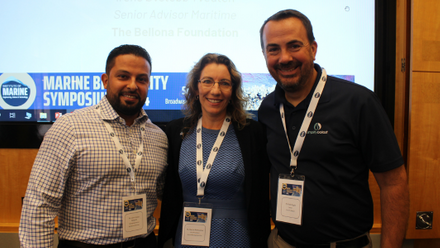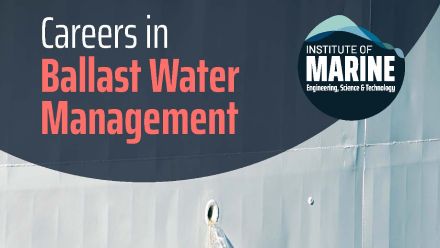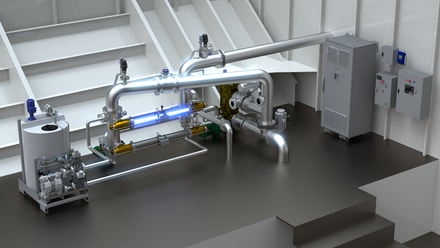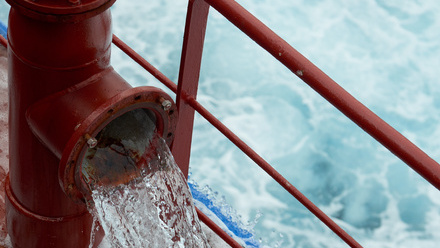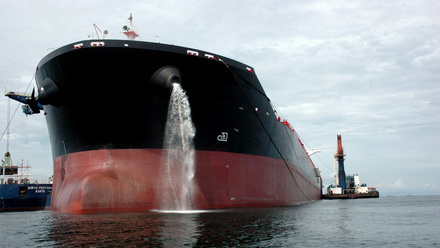Ballast Water Convention: Overcoming the compliance challenges
Many face challenges to implement and comply with the Ballast Water Convention – but there are solutions.
IMarEST Fellows Kevin Reynolds, Managing Director of oneTank (a Glosten company), and Marcie Merksamer, Vice President, EnviroManagement, explain more and preview the 7th IMarEST Ballast Water Technology Conference.
We’ve come a long way in how we manage ships’ ballast water. The world’s fleet is being refitted with ballast treatment plants at a rapid rate and the industry is very different from those early days when, for example, it was claimed to be “impossible” for ballast water to be treated onboard effectively.
Yet challenges remain and there is still much to learn, particularly when it comes to implementation and compliance monitoring. So much so, that it is the theme of the 7th IMarEST Ballast Water Technology Conference taking place online this month.
The IMarEST has been a thought leader in ballast water since 2004 when the Convention was first adopted. The conference will see global experts cover practical topics, including ballast water management plans and commissioning testing, as well as evolving themes such as compliance monitoring tools.
The focus will be on original research, lessons learned, and engineering and technology innovations, write Kevin Reynolds and Marcie Merksamer.
Learnings to date
Since the Ballast Water Convention was introduced, we have learned that simplicity wins. This was true from the very beginning as some of the more complex technologies either evolved to simpler set-ups or washed-out of the marketplace.
This was based on the experience of the engineering teams that learned to implement laser scanning, 3D-piping and arrangements, and pre-fabrication to allow fitting periods to take place within a reasonable shipyard period.
The scientific community, meanwhile, has made strides in understanding reliable biological efficacy testing methods in complex water samples, appropriate challenges for type-approval testing, and insights into environmental considerations for differing ballast water treatment technologies.
Emerging shipping trends
Many shipping companies with larger fleets have made their decisions and incorporated this major expenditure into their fiscal planning.
We see the opposite for smaller companies and those that operate in less developed regions, as they often defer to their chosen shipyards to find a solution.
We are also seeing a continuation in the simplification of the technologies. There are now several no-filter system offerings and systems with no hold-time requirements. The market will determine if these serve niche markets or move into being major suppliers.
With respect to compliance, there is a promising increase in the knowledge that many shipowners have about their vessel compliance requirements. It’s an important trend demonstrating that more shipping companies are making the effort to understand what is required and put plans in place to implement.
Better ship owner knowledge may also be as a result of an increase in the development and availability of industry guidance, as well as service providers with the necessary competencies to support ship owners.
Recipe for success
There is little success without planning. Owners who put effort into understanding how their ballast treatment system integrates into operations and identify new ways of thinking that are needed to effectively implement – and then plan accordingly – will find that achieving and maintaining compliance is very feasible.
Also, when they identify areas where they need support from service providers, taking time to select those with the proper expertise – versus the lowest price – will yield high-value benefits.
It’s important that shipping companies select service providers that can offer comprehensive support when compliance challenges arise, rather than just when it all goes smoothly.
Ballast water treatment technologies have been proven to work through the type-approval process, but achieving compliance means resolving a few key challenges:
- Picking the right system for the vessel: For example, if the vessel is heading into freshwater, the salty feedwater for electrolytic-based systems needs to be considered. Also, for a dredging vessel, the entrained sediment will challenge any UV lamps
- Focus on the installation, operation, and maintenance: Compliance favours the simpler systems, and those with robust engineering, commissioning, and service programs. During COVID travel restrictions, this means finding firms that partner with local engineering teams in locations such as China and Turkey
- Partner with a compliance monitoring team that can help with testing and sampling to meet IMO commissioning testing and US EPA requirements.
When things go wrong
Things don’t always go as expected, which is why the IMarEST has long been focused on contingency measures, and it was very helpful when MEPC accepted our small edit that added contingency measures as a recommended part of the ballast water management plan.
The upcoming 7th IMarEST Ballast Water Technology Conference will have a session on ballast water management plans, which is an important resource for crews to reply upon when things go wrong, including pre-determined troubleshooting methods to relieve upset conditions both at sea and in port.
7th IMarEST Ballast Water Technology Conference, 17-18 March 2021
The 7th IMarEST Ballast Water Technology Conference will bring together global leaders in ship operations, technology development and regulatory compliance in a virtual conference that will include a new online feature allowing delegates to seek out and have a virtual networking meeting with peers, suppliers, and customers.
Find out more and book at imarest.org.

Kevin Reynolds, Managing Director of oneTank (a Glosten company), FIMarEST and Marcie Merksamer, Vice President, EnviroManagement, FIMarEST

